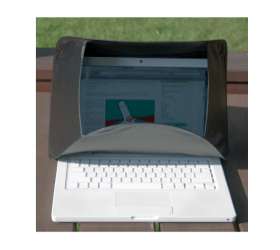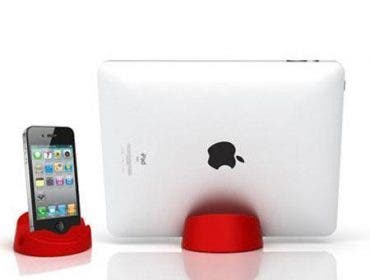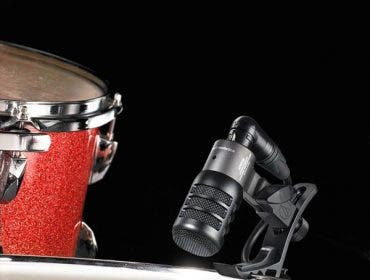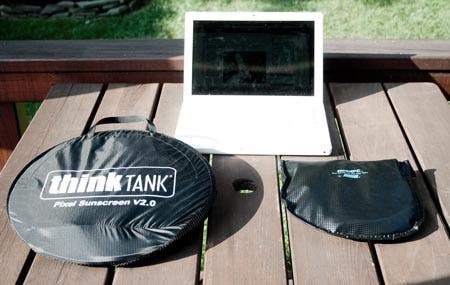
Both of these sun shades fold into flat carrying cases for portability. That is a 13-inch MacBook for size comparision. This photo was deliberately exposed for the black tones on the sun shades, to show the high contrast and brightness range of working in direct sunlight on your laptop.
News photographers, location shooters, and your favorite TechTock bloggers among others, all have the very real need of having to work outside from time to time (or “very real possibility on nice days of”, if you prefer). And as we all know, a laptop screen–whether matte or glossy–plus daylight (even partial shade), equals very low contrast on monitors, which leads to squinting, and a lot of frustration for even the simplest tasks like responding to an email. And when it comes to more intensive tasks like photo editing and color correction–forget it! Without a screen shade of some sort, you’re just spinning your wheels.
My wife (who is also lucky enough to be able to work from her laptop PC in the great backyard quite frequently) and I have spent some time with both Think Tank’s Pixel Sunscreen V2.0 and Hoodman’s new HoodPC screen shade designed for 13-15 inch PCs (There’s also a new HoodMac, designed specifically for the Macbook line, too!) and we’ve come to these conclusions:
- If you need or want to spend any time working out of doors on your laptop, a screen shade significantly improves overall screen visibility and apparent contrast.
- Both the Hoodman and the Think Tank shades have their own strengths and shortcomings. One is not clearly superior to the other in enough ways to make one the superlative hands-down winner. It really comes down to a matter of personal choice based on each product’s offerings.
Hoodman’s HoodPC and HoodMac shades
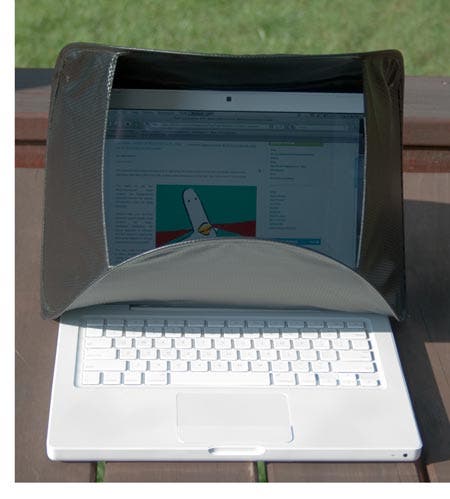 Hoodman’s new HoodMac and HoodPC shades each sell for just under forty bucks. The HoodPC version we tested folds away into a D-shaped carrying pouch that is roughly 10 inches wide by 10 inches tall, or about 12 inches diagonally from the top point of the D through to the lower curve midpoint. Unfolded, it is a sort of trapezoidal “hat” that wraps around just the laptop screen in a matter similar to barn doors on a studio strobe.
Hoodman’s new HoodMac and HoodPC shades each sell for just under forty bucks. The HoodPC version we tested folds away into a D-shaped carrying pouch that is roughly 10 inches wide by 10 inches tall, or about 12 inches diagonally from the top point of the D through to the lower curve midpoint. Unfolded, it is a sort of trapezoidal “hat” that wraps around just the laptop screen in a matter similar to barn doors on a studio strobe.
Each version has a few snaps to allow for hugging on to smaller laptop screens by shrinking the rectangular opening at the rear of the hood. The build is two-ply, with the inner nylon fabric more matte than the woven outer layer.
Once the hood is attached to the laptop, the carrying pouch can be velcroed to the top of the hood to act both as a counterbalance and to limit light intrusion. In all but the most severe direct sunlight conditions, it is possible to work with normal posture. When the angle of the sun is directly into the Hoodman shade, hunching closer the screen makes a difference. Adjusting the angle of the Hoodman shade and the laptop screen up or down slightly can also help, although due to the screen-wraparound design, lower angles can sometimes interfere with typing, particularly when doing number-intensive work. As the design simply wraps the screen, there’s no implications or interference with classic “lap-top” based computing.
The bottom line on Hoodman’s HoodMac and HoodPC laptop shades:
- Hoodman’s new HoodMac and HoodPC offer significant improvement over the bare screen experience.
- In all but the most severe sunlight situations, users can maintain an ergonomic non-hunched working position when working tabletop.
- Screen-wrap only design does not create challenges for “lap-top” computing.
- The small footprint when folded and stowed makes it very appealing as it can easily slip into a laptop pocket.
- Nicely priced at under forty dollars.
Think Tank’s Pixel Sunscreen V2.0
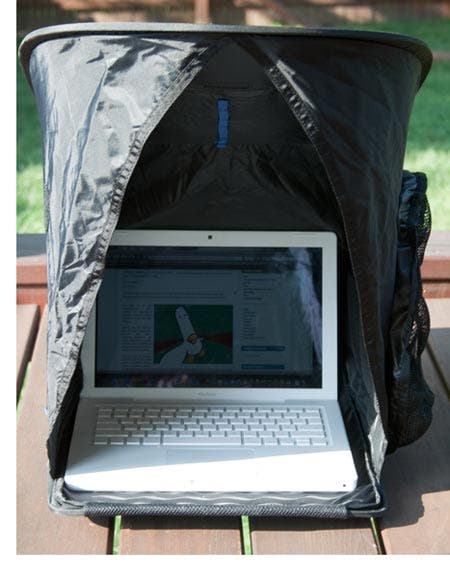
When first seeing the unfurled size of Think Tank’s Pixel Sunscreen V2.0 laptop tent it is hard to believe that that well-built $69 laptop screen folds down and onto itself into an integrated 15 inch diameter circular carrying case with handle.
Build quality is up to Think Tank’s exacting standards, and creature comforts include rear and side velcro openings for powering peripherals and power packs, regardless your laptop configuration, internal pockets and a dangling clip. The “floor” of the tent is deep enough to easily hold even today’s largest laptop computers, and the hood design allows for easy typing and screen viewing. In extreme sunlight conditions, there is a cape that can be drawn over the main opening in a modern day tribute to the classic field camera experience. In hot and humid sunny weather, it can get quite stifling under the hood very quickly! But if it a matter of being a little hot, or blowing deadline, we reckon most field-based photographers will be willing to suffer briefly.
Users of smaller and lighter laptops may notice some situations where the support wires in the sides of the floor assembly rock back and forth a bit on hard surfaces. Likewise, classic “lap-top” computing takes some practice, as one must balance the weight of the computer and the support struts for best user experience. The fifteen inch stowed radius is too large to neatly fit alongside a laptop in the laptop pocket in either the Think Tank Urban Disguise 50 or the Think Tank Shape Shifter.
The bottom line on the Think Tank Pixel Sunscreen V2.0:
- The Think Tank Pixel Sunscreen V2.0 offers significant improvement over the bare screen experience.
- Rock-solid build with velcroed pass-throughs for any laptop configuration.
- Excellent ergonomic (non-hunched) sunblocking experience during tabletop operations in even the harshest lighting conditions with the optional extreme conditions cape.
- No interference with typing whatsoever regardless of sun angle.
- Doubles as a quick and dirty “dark tent” for reflection minimization and object isolation with macro/tabletop work (with the addition of a sheet of copy paper for a seamless white sweep.
If you can or must work on your laptop outdoors in daylight, you really owe it to yourself to make your life much easier with a sun screen. Either one of these solutions will serve you very well in the field.
